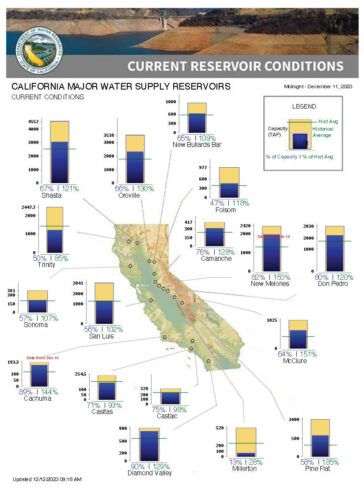Navigating California’s 2024 Tomato Crop with Caution and Optimism
Processing tomato crops flourished this season thanks to California’s exceptional summer and fall growing conditions. Inventory levels have been buffered, and a respectable carryover stock is anticipated for 2024. However, the sunny skies and minimal to no rainfall that facilitated processing until early November have extended into December. While the dry conditions allowed for successful fall ground preparation, California growers, with the holidays approaching, are hopeful for abundant rainfall and snow.
With carryover stocks back in balance, the urgent need to begin transplanting as soon as possible has finally eased. Waiting until late February or early March will provide optimal conditions for the young plants emerging from the greenhouses.
Currently, California’s northern and central reservoirs are at around 120% of historical levels and are at approximately 65% of capacity. While this is a positive starting point for 2024, initial California State Water Project (SWP) allocations, as of December 1, stand at only 10% due to minimal precipitation. The Central Valley Project’s (CVP) water allocations are still pending. As the days pass, California’s growers eagerly await the anticipated El Niño conditions promising another wet winter.
A primary concern for California’s growers is the 2024 tomato contracts. After wrapping up the 2023 crop year with 12.738 million short tons, California’s processors are looking towards 2024 with plans for a slightly lower tonnage, yet focusing on keeping factory run rates efficiently high. This presents a challenging situation for the state’s growers since many crops in competition with tomatoes, as well as most permanent crops, have faced depressed prices and demand, contributing to a growing interest in tomato contracts despite reduced pricing.
Additional reasons for gratitude and optimism include the minimal damage tomato crops experienced in 2023 from the curly top virus. The Beet Curly Top Virus program has enhanced its state scouting capabilities and research. The wet conditions during the 2023 grower season played a crucial role in minimizing damage from the virus. Furthermore, advancements in tomato genetics continue to improve varieties, resulting in optimal tomatoes for growing and processing with enhanced disease resistance.
A new state-sponsored agency will become active after the first of the year, addressing the broomrape situation in parts of Northern California. This agency will be tasked with forming a strategic plan and mission on how to deal with this menacing parasitic weed. Other countries have taken a strong proactive approach to preventing its spread and have seen great results.
As California’s tomato industry navigates the challenges of fluctuating water allocations and reduced contract intentions, the state’s growers and processors remain cautiously optimistic. With promising reservoir levels, the industry is poised for success in 2024, provided the anticipated El Niño conditions bring the much-needed rainfall for a prosperous growing season ahead.
###

Morning Star Newsletter now distributed electronically
As a reminder, Morning Star is now distributing our newsletters electronically using an email distribution vendor called Mailchimp. Your e-version will now include informative Morning Star videos and highlights. Depending on your company’s firewall, these emails may initially be directed to you spam folder.



